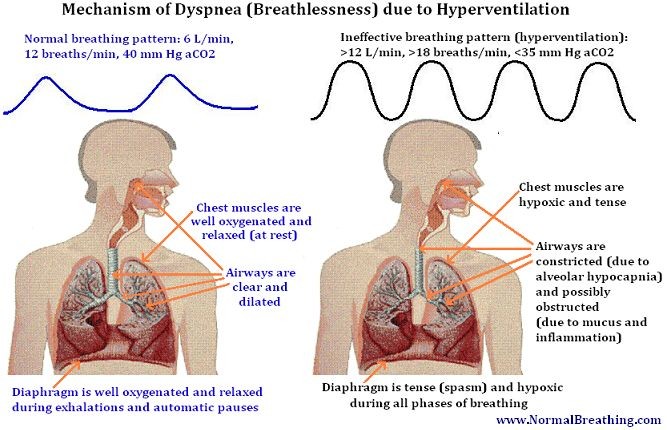
Contents
- 1 How Does Dyspnea Affect the Body?
- 1.0.1 Symptoms of dyspnea
- 1.0.2 Causes of dyspnea
- 1.0.3 When to see the doctor for dyspnea
- 1.0.4 Treating dyspnea
- 1.0.5 When should I be concerned about my child’s breathing?
- 1.0.6 What causes respiratory problems?
- 1.0.7 How to prevent respiratory problems
- 1.0.8 Subscribe to MedicineNet’s Allergy and Asthma Newsletter
How Does Dyspnea Affect the Body?
Patients with dyspnea often experience tightness of the chest and a smothering sensation, leading to anxiety and psychological distress that exacerbates symptoms.
Dyspnea, or shortness of breath, is a symptom rather than a condition or disorder. It can be caused by various medical conditions and is self-reported since healthcare professionals cannot observe its severity. Some facilities have patients rate their dyspnea similarly to rating their pain.
Many people encounter dyspnea at some point in their lives, with around one quarter of outpatients reporting breathlessness.
If you have dyspnea, managing the underlying cause should bring relief. If there is no cure, your doctor may suggest methods to alleviate shortness of breath.
Symptoms of dyspnea
It’s somewhat inaccurate to discuss dyspnea symptoms since it is already a symptom. However, individuals with dyspnea report the following:
Awareness of breath
Dyspnea is described as an abnormal awareness of breathing, which can cause discomfort and anxiety due to the generally unconscious nature of breathing.
Tightness of the chest
Dyspnea can result in a feeling of chest constriction, preventing deep breaths and leading to a smothering sensation. This sensation is sometimes referred to as air hunger, and some people feel they must exert extra effort to breathe.
Other sensations
Other reported sensations associated with dyspnea include feeling overheated, panicky, or overwhelmed. For some, dyspnea can be debilitating.
Causes of dyspnea
While dyspnea can be caused by low blood oxygen levels, this is not always the case. Anxiety is one potential cause, and shortness of breath is a common symptom of panic attacks. However, most cases of dyspnea are related to physical conditions falling into the following categories:
Respiratory causes
Dyspnea can be triggered by respiratory problems like asthma and chronic obstructive pulmonary disease (COPD), although not all cases originate from lung and respiratory issues.
Cardiovascular causes
Cardiac problems can lead to dyspnea when the heart fails to pump enough oxygenated blood. Signs of heart trouble often accompany dyspnea, such as reduced heart sounds or an irregular heartbeat.
Conditions of the nerves and muscles
Amyotrophic lateral sclerosis, myasthenia gravis, and physical deconditioning can contribute to dyspnea. Deconditioning may result from surgery, illness, or a sedentary lifestyle.
When to see the doctor for dyspnea
In situations such as exertion, high temperatures, and high elevations, dyspnea can occur even in healthy individuals. If you are overweight, you may also experience shortness of breath more easily, which does not require medical attention.
However, if breathlessness suddenly impedes your ability to function normally or you observe additional concerning symptoms like chest pain, nausea, or fainting, immediate medical care is recommended. Symptoms such as bluish nails, mental confusion, wheezing, swollen ankles, or difficulty breathing while lying flat also warrant immediate attention.
For less acute cases of dyspnea, it is advisable to consult a doctor, although it may not require a trip to the emergency room.
Treating dyspnea
Treating the underlying cause of dyspnea generally provides relief. Medications or inhalers that aid breathing may also be prescribed. If oxygen levels are low, supplemental oxygen might be beneficial.
Lifestyle changes like weight loss can significantly improve dyspnea, as obesity increases the risk of respiratory issues. Joint pain and other movement difficulties can also result from being overweight, contributing to deconditioning.
If the underlying cause of dyspnea cannot be treated, or if the cause remains unknown, breathing techniques can offer relief. Pulmonary rehabilitation programs can provide guidance in this regard. Additionally, using a hand-held fan to direct air toward the face has benefitted 72% of participants across three studies.
When should I be concerned about my child’s breathing?
Respiratory infections are common in children and can lead to breathing difficulties. Children under 3 years old often experience more severe symptoms and are at risk of becoming seriously ill without close monitoring.
Knowing the symptoms that indicate the need to visit a doctor is essential for parents. Signs of respiratory distress in children include pale or bluish skin around the lips, eyes, hands, feet, and nail beds; chest retractions (pulling in with each breath); flaring nostrils; wheezing; clammy skin; mood changes like irritability; drowsiness; difficulty waking up; loss of appetite; and changes in posture to facilitate breathing.
If your child struggles to breathe due to respiratory distress, immediate medical attention is necessary.
What causes respiratory problems?
Respiratory problems can stem from infections affecting the upper respiratory system, including the nose, mouth, sinuses, and throat. These infections are primarily caused by viruses but can also be bacterial or fungal. Symptoms of upper respiratory infections include nasal blockage, noisy breathing or snoring, discomfort, irritability, restlessness, loss of appetite, fatigue, cough, fever, and ear pain.
Lower respiratory tract infections affect the lungs and bronchi. Symptoms are more severe than those of upper respiratory infections and typically require medical attention. Causes include bacteria, viruses, and fungi. Symptoms include persistent coughing, fever, irritability, restlessness, decreased appetite, fatigue, difficulty breathing, rapid breathing, wheezing, flaring nostrils, and the use of neck, chest, and abdominal muscles to breathe.
Allergies are common in children and can contribute to respiratory problems. Symptoms associated with allergies include clear nasal drainage, nasal congestion, sneezing, watery eyes, and irritability.
Other factors that can cause respiratory problems include exposure to cigarette smoke, fumes, and pollutants; inhalation of foreign objects causing airway obstruction; and genetic disorders like cystic fibrosis.
How to prevent respiratory problems
Preventing breathing problems entirely is not always possible, particularly in children. However, taking the following measures can reduce the risk of numerous respiratory infections:
- Avoid exposing your child to cigarette smoke, fumes, and pollutants.
- Maintain a dust-free environment.
- Be cautious of essential oils in humidifiers, indoor air fresheners, perfumes, and mold in vents, as children may be allergic to them.
- Avoid using baby powder or cornstarch on your child, as it can irritate their lungs.
- Promote good hand hygiene among caregivers and ensure that your child maintains proper hand hygiene.
- Keep your child away from sick individuals.
Subscribe to MedicineNet’s Allergy and Asthma Newsletter
By clicking "Submit," I agree to the MedicineNet Terms and Conditions and Privacy Policy. I also consent to receiving emails from MedicineNet and acknowledge that I may opt out of MedicineNet subscriptions at any time.
Sources:
American Family Physician: "Causes and Evaluation of Chronic Dyspnea."
American Journal of Respiratory and Critical Care Medicine: "Dyspnea: Don’t Just Look, Ask!"
Bass, J. Clinical Methods: The History, Physical, and Laboratory Examinations. Butterworths, 1990.
British Lung Foundation: "Breathlessness."
Cancer.net: "Shortness of Breath or Dyspnea."
Cleveland Clinic Center for Continuing Education: "Dyspnea."
European Respiratory Journal: "Fooling the brain to alleviate dyspnoea."
Mayo Clinic: "Shortness of breath."
Maturitas: "Understanding dyspnea as a complex individual experience."
UpToDate: "Causes of Acute Respiratory Distress in Children."
BJA Education: "Paediatric Respiratory Distress."
Asthma and Lung UK: "Breathing Problems to Look Out for in Children."
WebMD: "Breathing Problems in Children."
WebMD: "Breathing Problems in Children."


